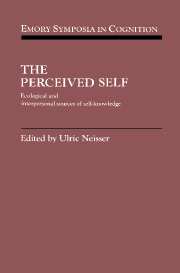Book contents
- Frontmatter
- Contents
- Preface
- List of contributors
- Part I Introduction
- Part II The concept of an ecological self
- 2 Ontogenesis of the perceived self
- 3 Body–environment coupling
- 4 A theory of representation-driven actions
- 5 The ecological self in historical context
- 6 Good intentions and dancing moments: Agency, freedom, and self-knowledge in dance
- 7 The primacy of the ecological self
- Part III The interpersonal self and its implications
- Author index
- Subject index
3 - Body–environment coupling
Published online by Cambridge University Press: 29 March 2010
- Frontmatter
- Contents
- Preface
- List of contributors
- Part I Introduction
- Part II The concept of an ecological self
- 2 Ontogenesis of the perceived self
- 3 Body–environment coupling
- 4 A theory of representation-driven actions
- 5 The ecological self in historical context
- 6 Good intentions and dancing moments: Agency, freedom, and self-knowledge in dance
- 7 The primacy of the ecological self
- Part III The interpersonal self and its implications
- Author index
- Subject index
Summary
Like all animals, we exist by virtue of coupling our bodies to the environment through action. Inadequate coupling, whether it be on the perceptual side, as when driving in fog, or on the movement side, as caused by muscular dysfunction, can be a prescription for disaster. Perception is necessary for controlling movement just as movement is necessary for obtaining perceptual information. Perception and movement compose a cycle that is action.
Action in the environment is the root of the ecological self (Neisser, 1988). As Neisser has so neatly put it in this volume: We are what we do. Therefore, to understand the self, we need to understand how actions can be geared to the environment. The first point to note is that control has to be prospective. If we see a person or animal going around bumping into things, we think something clearly must be wrong – so much do we take prospective control for granted. For to avoid colliding with objects, the consequences of continuing one's present course of action (such as heading in a particular direction, braking with a particular force) must be perceived and evasive action taken in time.
- Type
- Chapter
- Information
- The Perceived SelfEcological and Interpersonal Sources of Self Knowledge, pp. 43 - 67Publisher: Cambridge University PressPrint publication year: 1994
- 1
- Cited by

